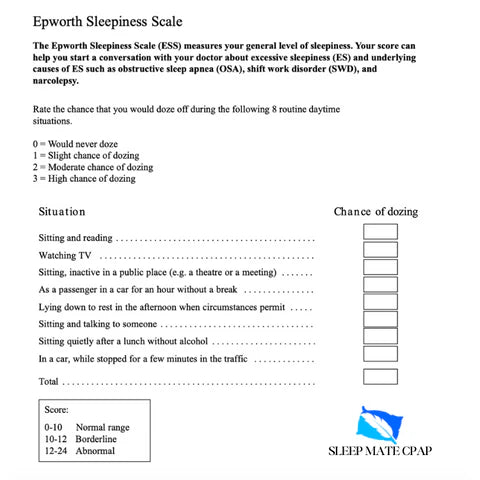
Understanding the Epworth Sleepiness Scale: A Gateway to Sleep Apnea Diagnosis
Do you ever find yourself fighting drowsiness during the day? You're not alone. Excessive daytime sleepiness (EDS) is a common symptom affecting millions, and it could be a sign of an underlying sleep disorder like obstructive sleep apnea (OSA). The Epworth Sleepiness Scale (ESS) is a valuable tool used by doctors to assess daytime sleepiness and screen for potential sleep disorders, particularly OSA[1].
What is Excessive daytime sleepiness?
Excessive daytime sleepiness (EDS) is characterised by drowsiness that arises when a person wants or needs to be awake and alert. EDS affects as many as 25% of people [2] and can impact a person’s daily life by imparing concentation, reducing performance at work and school, and heightening the risks of serious accidents, including when driving a motor vehicle [1].
The History of the Epworth Sleepiness Scale
Developed in 1990 by Dr. Murray Johns, a prominent Australian sleep specialist, the ESS offers a simple and effective way to gauge a person's propensity to doze off in everyday situations.
How Does the ESS Work?
The ESS is a short, self-administered questionnaire designed to assess your level of daytime sleepiness. It asks you to rate how likely you are to doze off in eight common scenarios, providing valuable insights into your sleep-wake patterns:
- Sitting and reading
- Watching television
- Sitting quietly in a public place (like a theater or a meeting)
- Riding as a passenger in a car for an hour without stopping
- Lying down to rest in the afternoon when circumstances permit
- Sitting and talking to someone
- Sitting quietly after lunch without alcohol
- Sitting in stopped traffic for a few minutes
Understanding Your ESS Score
Each scenario in the Epworth Sleepiness Scale is assigned a score of 0 to 3, reflecting the likelihood of falling asleep in that situation:
- 0 = No chance of dozing
- 1 = Slight chance of dozing
- 2 = Moderate chance of dozing
- 3 = High chance of dozing
Your total score falls between 0 and 24. Generally, a higher score indicates a greater degree of sleepiness. Here's a breakdown of what your ESS score might indicate [4]:
- 0 to 10: Normal range of sleepiness in healthy adults
- 11 to 14: Mild sleepiness
- 15 to 17: Moderate sleepiness
- 18 to 24: Severe sleepiness
The Link Between High ESS Scores and Sleep Apnea
A score of 11 or higher suggests excessive daytime sleepiness (EDS), which could be a symptom of an underlying sleep disorder like sleep apnea. While EDS itself isn't a sleep disorder, it's a common symptom of various conditions, including sleep apnea and narcolepsy. It is important to note that the ESS score alone is not definitive in determining whether a person has excessive daytime sleepiness. A person’s ESS score may vary when taken at different times [3].
The ESS: A Stepping Stone to Better Sleep
If your Epworth Sleepiness Scale score falls within the excessive sleepiness range (11 or higher), your doctor may recommend further evaluation by a sleep specialist to determine the cause and explore treatment options. The ESS is a valuable first step in identifying potential sleep disorders and paving the way for a better night's sleep and improved daytime alertness.
Taking Control of Your Sleep Health
If you suspect you might have sleep apnea or another sleep disorder, don't hesitate to speak with your doctor. Early diagnosis and treatment can significantly improve your sleep quality and overall health [5]. Sleep apnea can be effectively managed with various treatment options, including CPAP therapy.
SleepMate CPAP: Your Partner in Better Sleep
At SleepMate CPAP, we understand the importance of a good night's sleep. We offer a wide selection of high-quality CPAP machines, masks, and other sleep apnea supplies to help you manage your sleep apnea effectively and achieve a more restful sleep. Visit our website at SleepMate CPAP to browse our selection and take control of your sleep health today!

References:
- Epworth Sleepiness Scale: [https://www.sleepfoundation.org/sleep-studies/epworth-sleepiness-scale]
- Approach to the patient with excessive daytime sleepiness [https://www.uptodate.com/contents/approach-to-the-patient-with-excessive-daytime-sleepiness]
- A requiem for the clinical use of the Epworth Sleepiness Scale. Journal of Clinical Sleep Medicine. [https://pubmed.ncbi.nlm.nih.gov/29734996/]
- Epworth Sleepiness Scale [https://my.clevelandclinic.org/health/diagnostics/epworth-sleepiness-scale-ess]
- About the ESS [https://epworthsleepinessscale.com/about-the-ess/]

